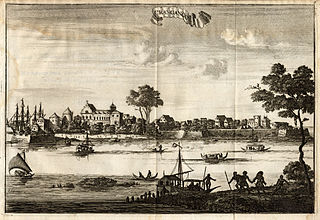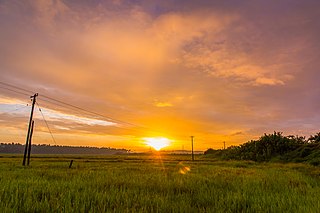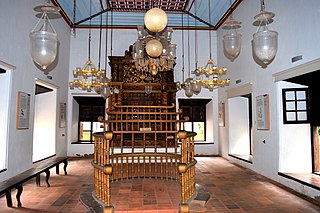
Kodungallur is a historically significant town situated on the banks of river Periyar on the Malabar Coast in Thrissur district of Kerala, India. It is 29 kilometres (18 mi) north of Kochi (Cochin) by National Highway 66 and 38 km (24 mi) from Thrissur. Kodungallur, being a port city at the northern end of the Kerala lagoons, was a strategic entry point for the naval fleets to the extensive Kerala backwaters.
North Paravur, is a municipality in the Ernakulam district of Kerala, India. It is located 20 km (12.4 mi) north of the district collectorate in Thrikkakara and about 201 km (124.9 mi) north of the state capital Thiruvananthapuram. North Paravur is part of the Kochi metropolitan area and is located 19 km (11.8 mi) north of the Kochi city centre. As per the 2011 Indian census, North Paravur has a population of 31,503 people, and a population density of 3,490/km2 (9,000/sq mi).

Thrissur, anglicised as Trichur, is one of the 14 districts in the Indian state of Kerala. It is situated in the central region of the state. Spanning an area of about 3,032 km2 (1,171 sq mi), the district is home to over 9% of Kerala's population.
Pavaratty is a census town in Thrissur district in the Indian state of Kerala. Pavaratty is situated in the coastal area of Chavakkad taluk in Thrissur District. The town is about 23 km north-west of Thrissur town and 5 km south of Guruvayoor. It is the site of St. Joseph's Parish Shrine, Pavaratty and also lies near Palayur (4 km), famous for the Palayur Church. Nearby airports are Cochin International Airport (77 km) and Calicut Airport (95 km). The nearest railheads are at Guruvayoor and Thrissur. The Nearest bus stations are Thrissur Bus Station and Guruvayoor Bus Station. From Thrissur, the shortest way to Pavaratty is via Amala-Parappur-Puvathur.

Chavakkad, formerly Chowghat, is a municipality in the Thrissur district of the Indian state of Kerala. Chavakkad is noted for its beach and fishing. It lies on National Highway 66 is located about 75 km (47 mi) north of the city of Kochi, 25 km (16 mi) northwest of Thrissur, and 24 km (15 mi) south of Ponnani.

This article lists the various old and ancient churches that exist among the Saint Thomas Christians in Kerala.
Pazhanji is a village with near Kunnamkulam in Thrissur district in the state of Kerala, India. The name "Pazhanji" is derived from the Malayalam word for "old".

Vatanappally (Vatanappilly/) is a panchayat and census town in Thrissur district, in the state of Kerala, India.

.

Palayur Mar Thoma Major Archiepiscopal Church, is located at Palayur, in Thrissur district in Kerala on the west coast of India. According to Saint Thomas Christian tradition, the Syrian church was established in 52 AD by St Thomas, one of the twelve apostles of Jesus Christ. Saint Thomas performed the first baptism in India here, therefore this church is called an Apostolic Church credited to the apostolate of St. Thomas, who preached and also introduced Christianity to the people here. It is part of the Ēḻarappaḷḷikaḷ that he established in India, the others being at Cranganore, Kokkamangalam, Kottakkavu, Kollam, Niranam, and Chayal (Nilackal). The original small church structure has been retained at the original site. But substantial improvements around it were carried out during the 17th century by Giacomo Fenicio as necessary, without sacrificing the main sanctity of the place.

The following outline is provided as an overview of and topical guide to Kerala:

The Mala Synagogue is one of the oldest extant synagogues in India and was built by the historic Malabar Jews of Kerala. It is located at Mala, a small town in Thrissur district of Kerala state in south India.
Ēḻarappaḷḷikaḷ or Ezharappallikal, are the seven major churches or Christian communities of Saint Thomas Christians across Malabar Coast of India that are believed to have been founded by Thomas the Apostle in the first century. According to Indian Christian traditions, the apostle Thomas arrived in Muziris (Kodungallur) in AD 52, established the Ezharappallikal and evangelised in present-day Kerala and Tamil Nadu. Many of these churches built near Jewish and Brahmin settlements. These were at Maliankara (Kodungallur), Kollam, Palayoor, Kottakkayal, Kokkamangalam, Niranam and Nilackal (Chayal). Thiruvithamcode church in Kanyakumari was built on the land given by arachan (king) and hence it is often referred in the name Arappally. Similarly, the Churches at Malayattoor and Aruvithura are also referred to as Arappallikal.

Arthat St Mary's Orthodox Cathedral also called Kunnamkulam-Chattukulangara Church is an ancient church located in Arthat village of Thalapilly Taluk, one mile south of Kunnamkulam town, Thrissur, Kerala, India. This church did not participate in the Synod of Diamper. During the invasion of Tippu Sultan the church was arsoned and later reconstructed.
Thrissur is a district of Kerala situated in the central part of that state in South India. Spanning an area of about 3,032 km2 (1,171 sq mi), Thrissur district is home to over 9% of Kerala's population.
St. Joseph Church, Aloor is a parish of the Syro-Malabar Catholic Church in Aloor. It was the first parish church in Aloor Muri of the Mukundapuram and Kodassery taluks. Aloor parish is one of the 83 parishes between the Bharathappuzha and Periyar rivers, during the erection of syro-Malabar hierarchy and Trichur Vicariate.

The Chendamangalam Synagogue is one of the oldest known synagogues built by the Malabar Jews, in Chendamangalam, a village in the Ernakulam district of the coastal state of Kerala. It is dated to 1100 A.D., though the synagogue structure itself dates to 1420 A.D or 1614 A.D., making it the oldest synagogue in the Commonwealth of Nations. A tombstone recovered from Kodungallur was stored in this synagogue and is presently on display in the front yard. This tombstone with the inscription of Sarah Bat Israel is the second oldest Jewish epitaph found in India, dating to 1269 A.D.
Palayur Mahadeva Temple was a legendary temple located in Palayoor near Chavakkad in the Thrissur district in ancient Kerala. This Shiva temple was later converted into a Christian church with the arrival of St. Thomas in Malabar, Kerala. Palayoor Mahadeva (Siva) Temple does not exist today. The temple is believed to be constructed by the first Chera king of Kodungallur. This temple is one among the 108 Shiva temples established by Parasurama. The legends suggest that the installation of the idol of god Mahadeva (Shiva) was performed by Parasurama himself.

The Kadavumbhagham Ernakulam Synagogue in Kerala, India, is the restored oldest synagogue of the Malabar Jews with a Sefer Torah scroll and offering occasional services. It was established in 1200 CE and restored several times through the centuries on the same site. It is modeled on the earliest synagogue of the Malabar Jews at Muziris, which dated from the time of ancient sea trade between the Mediterranean and Kerala.















